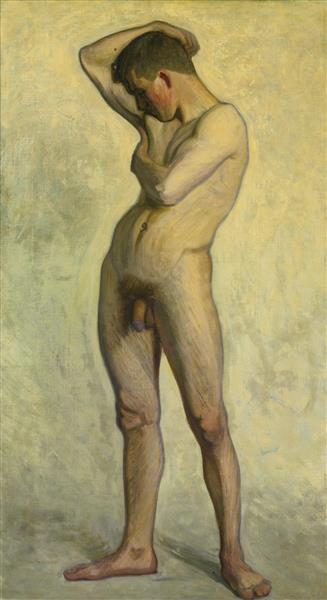Description
The painting "Garçon Nu" by Eugène Jansson, created in 1906, is a work that reveals the artist's mastery in the representation of the human body and its connection with the symbolism of the environment. Jansson, highlighted within the movement of Swedish painting at the end of the 19th and early twentieth centuries, is distinguished by its focus on the figure and use of color, both elements that converge harmoniously in this work.
The composition of "Garçon Nu" is notable for its use of space and angle of the figure. The naked young man presents himself frontally, exhibiting his body in a pose that reflects both vulnerability and serenity. The figure seems to emanate a feeling of calm and introspection, inviting the viewer to contemplate not only the physical form but also the essence of the character. The soft curve of its torso and the fall of the arms suggest an organic connection with the surrounding space, demonstrating a deep understanding of the anatomy and human posture.
Color is another fundamental component in this painting. Jansson uses a palette that ranges between warm and cold tones, creating a contrast that enhances the textures of the body and the background. Color nuances apply with care that gives three -dimensionality to the figure, highlighting the lights and shadows that play on their skin. The background, which slides between a deep blue and a soft white, effectively contrasts with the clearest tone of the model's skin, directing the observer's attention to the naked body.
The artist, influenced by symbolism and modernism, seems to propose a fusion between the human body and the elements of the environment. The simplicity of the figure in contrast to the emotional complexity of the background allows the viewer to reflect on the meaning of nudity in art. Jansson avoids the exaltation of trivial eroticism, in favor of a representation that suggests purity and contemplation. This approach to nudity as a state of being, both physical and spiritual, is central in Jansson's work and in the symbolism of his time.
While "Garçon Nu" does not belong to the current of academic art, it is related to other contemporary artistic movements that advocate authenticity in the representation of the human body. The work can be seen in dialogue with the works of painters such as Gustav Klimt and Henri Matisse, who also explored the human figure with a similar sensitivity, although with marked stylistic differences.
Eugène Jansson, a pioneer of modern Swedish painting, achieved with "Garçon Nu" to capture an instant of introspection and beauty. His legacy lasts in the way he gave the human body its prominent place in the artistic narrative, challenging the viewer to see beyond superficiality and connect with the very essence of life and vulnerability in each stroke and color. The work is ultimately a celebration of nudity as a state not only physical, but also existential, resonating in the time and space in which it was created.
KUADROS ©, a famous paint on your wall.
Hand-made oil painting reproductions, with the quality of professional artists and the distinctive seal of KUADROS ©.
Art reproduction service with satisfaction guarantee. If you are not completely satisfied with the replica of your painting, we refund your money 100%.

